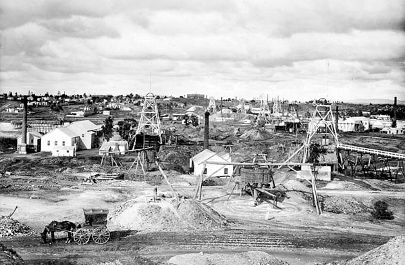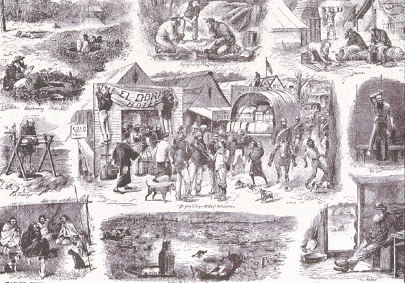Gold mines
Gold discovery
James Esmond – a veteran of the California goldrushes – made the first officially recognised gold discovery in Victoria at Clunes in 1850.
The discovery of gold at Ballarat in 1851 triggered Victoria's gold boom. Ballarat had the richest alluvial goldfields in the world during the peak in 1852 and 1853.
The rush spilled over to the Mt Alexander field at Castlemaine and by December 1851 the field had attracted 20,000 diggers and was yielding 23,000 ounces of gold a week.
Finding gold in the north
The search moved further north to the fabulous finds at Bendigo and in April 1852, two adjacent claims at Peg Leg Gully yielded a total of 324 pounds of gold.
The riches of nearby Eagle Hawk Gully were like a magnet, with up to 6000 diggers joining the rush each week. By June 1852 Bendigo had a population of 40,000.
Through 1853 there were gold discoveries at Daylesford, Creswick, Maryborough and Maldon. In the second half of the decade there were rushes to the west at St Arnaud, Ararat, Stawell, Dunolly, Rutherglen and Chiltern, Jamieson, Blackwood.
More gold discoveries
The gold rushes still went on in the 1860s. There were discoveries at Russells Creek, Gaffneys Creek, Crooked River, Woods Point, Donnellys Creek, Fultons Creek and Stringers Creek (Walhalla).
Mining in the 1860s was mainly on a large scale and reef mining was established in Ballarat, Bendigo, Clunes and Walhalla. Long term underground mining operations provided the basis for the establishment of regional towns in these areas.
There was a brief rush to Tarngulla in central Victoria in 1906 following the discovery of the Poseidon Nuggets – the largest being 953 ounces.
The end of the gold rush
Ballarat and Bendigo mines fell silent by the 1920s although there was a brief flurry of activity during the Great Depression of the 1930s.
The gold mining industry lay dormant until the 1980s. High gold prices at that time led to a surge in prospecting and fossicking using electronic detectors as well as a return to large mining operations at Stawell and Woods Point.
Present day gold mining
During the 1990s there has been increased interest in gold mining in Ballarat, Bendigo, Stawell, Fosterville, Maldon, Heathcote, Castlemaine and Tarngulla – the same areas that attracted earlier gold rushes. By the mid 1990s Victoria had 17 operating gold mines.
Images of gold mining in Victoria
More information about gold
Page last updated: 02 Jun 2021

